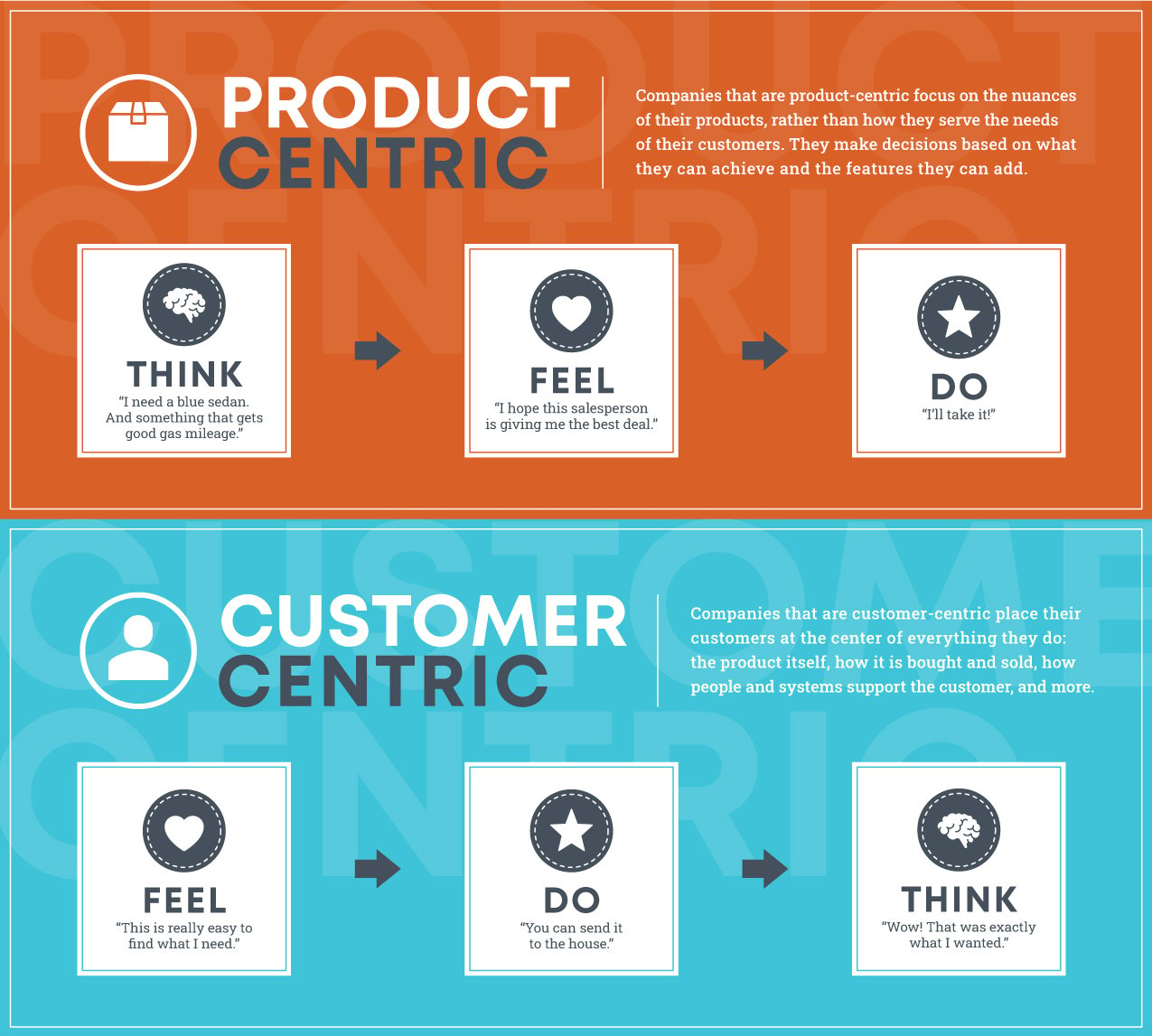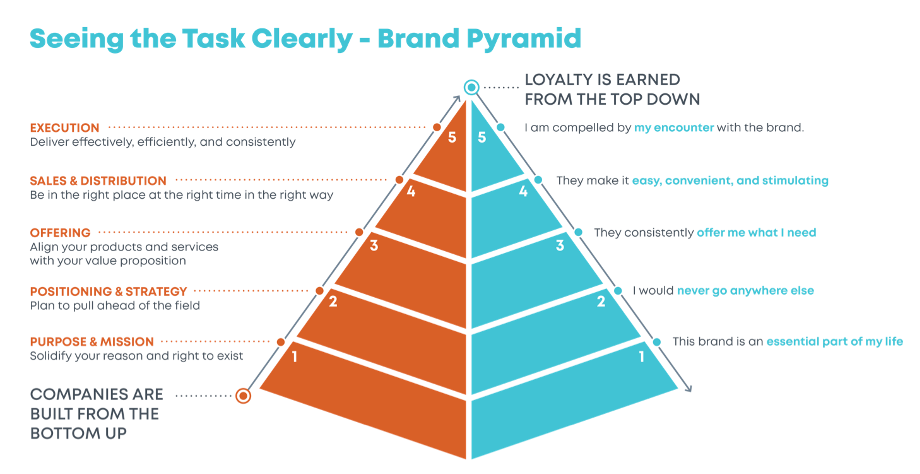Can’t Hear Your Customers? You Probably Need to be More Customer-Centric

Are you really listening to your customers? Or are you just tracking the easy stuff like NPS and going on with business as usual? Research from Deloitte suggests that customer-centric businesses are 60% more profitable than those that aren’t. But only 14% of companies believe that customer centricity is at the core of their practices.
Product-Centric vs. Customer-Centric: Deliver on Customer Needs for a Big Impact.
Companies that are product-centric focus on the nuances of their products, rather than how they serve the needs of their customers. Too often, product-centric businesses make decisions based on what they can achieve and the features they can add. And this may prevent them from developing solutions that adapt to and serve the needs of their customers by delivering real benefits.
To become customer-centric, on the other hand, place your customers at the center of everything you do: the product itself, how it is bought and sold, how people and systems support the customer, and more.
It is important to note that being customer-centric is not the same as being customer-friendly. Companies with prompt and friendly customer service are not automatically, by definition, customer-centric. And while the performance data above is compelling, many successful companies aren’t customer-centric.
Customer centricity is an organizing principle. It is the act of seeing the business — the people, policies, processes, products — all of it — through the eyes of the customer. And most importantly, it’s aligning how you operate with what’s best for the customer — even if it is sometimes operationally and financially challenging for the company.
One feature of customer-centric companies is that they listen to customer needs, wants, pain points, and frustrations. They create experiences that truly deliver what customers desire and deepen those relationships, making them stickier and making their brand a more integrated part of their customers’ lives.
For example, the way we buy cars is still very product-centric. We take off work to go to the dealership, meet with the salesperson, and test drive a few cars. Then we go to another dealership, meet with another salesperson, and test drive those cars. We look around for deals, check ratings on the internet, ask our friends for advice, and weigh our options. After all that, we negotiate the purchase and finally buy the car.
Sure, some cars are better than others. And some dealers are nicer and more transparent than others. But is that the experience customers really want?
Carvana took this model and flipped it on its head. They put the customer at the center of the buying experience. Through their service, customers can shop completely online from the comfort of their own home, their office, or anywhere in between. Once a customer finds a car that’s right for them, they can choose to have the car delivered, or they can pick it up at one of the company’s car vending machines — without ever talking to a single salesperson. That means no more carving out time to go to the dealership, no more waiting for the salesperson to talk to the manager, no more pressure to buy right now. It’s a process designed for customers first.
By identifying and removing all of the car-buying experience pain points, Carvana serves their customers with an innovative, convenient, and hassle-free approach. They deliver on their brand promise in a customer-centric way.
And while Carvana is a great example, customer-centric companies need not be category disruptors. Other well-known brands like Chick-fil-A, Nordstrom, USAA, Ritz-Carlton, and Amazon are widely considered to be leaders in customer centricity.
The Customer-Centric Mindset
If you’re wondering where to begin, start by building an understanding of your customers on a deeply human level. Recognize, as Carvana did, that needs aren’t features. Needs are the problems your products and services solve.
Then look at the steps of the customer experience in terms of their functional and emotional triggers. The goal is to bridge the functional benefits of what you offer — the head — with the emotional benefits — the heart — and move from a feature-led experience to a benefit-led experience.
The goal is to transition your customers’ decision-making process from “think, feel, do” to “feel, do, think.” By doing so, customers will feel that your brand is an essential part of their lives.

Carvana focuses on making customers feel understood and empowered. They deliver a surprising twist on the dreaded car buying experience. This modern approach makes consumers feel savvy and helps them recognize the shortcomings of the old way of doing business. Once they’ve connected emotionally, they can then solve for their functional needs: two-door or four-door, cloth seats or leather, and beyond.
This change to “feel, think, do” allows Carvana to create a deeper connection with their customers, solves the challenge of shopping around, and builds brand loyalty.
That’s the power of listening. It’s a constant feedback loop between you and your customers that drives product and service excellence. Sometimes, people know exactly what they want. And when you hear that from your customers, you have clear, actionable demands to meet.
Other times, people can’t articulate those needs exactly. In those cases, you’ll need to dig further to explore the exact frustrations, pain points, and behavioral drivers that exist in your customers’ lives. When you have a deeper understanding of the problems that your customers face, you can deliver solutions that resonate with them. That’s next-level customer centricity.
Just think: over a decade ago, nobody said they needed a phone that could check their email, browse the web, carry their music, play games, and pay for dinner — until Apple and others made it possible. Now, millions of people don’t just want the latest smartphone. They need it.
That’s what happens when you listen, understand, and deliver on customers’ needs.
Three Ways Your Company can be More Customer-Centric
1. Commit to it.
Your commitment to customer centricity can’t just be a poster on the wall. It must be part of your company purpose and built it into your DNA — at a fundamental and cultural level.
The best brands are built from the inside out. And that means your company needs to unify around a common purpose — to start with why. Why does your company exist? How is the world better because your company is in it? Everything else follows from there: your brand’s mission, your values, how you execute. Your “why” is your North Star.
When leadership makes a commitment to customer centricity, they empower everyone inside your company to live by a collective set of values and a shared purpose. Be transparent about your company purpose and find people who will dedicate themselves to living and aspiring to achieve it. If employees understand what your company is trying to achieve and believe in it, they will expend more energy making your customers feel it too.
Amazon is a great example of this. Their corporate vision is “to be Earth’s most customer-centric company.” And that customer obsession is ingrained in the company’s culture and its processes. From one-click ordering to the importance of reviews to easy return processes, Amazon’s entire business has been built on making customers’ lives easier.
To reinforce this mindset, every Amazon employee works two days every two years at the customer service desk — including Jeff Bezos himself. That kind of commitment can’t be faked. It must be earned.
Own it: How to live and breathe your brand’s purpose and values.
One, get your team on board. Clearly define and explain your values to your team. These are the desired behaviors that will help you achieve your vision. Pull your values into internal conversations as much as possible. Mention them when encouraging your employees to go the distance.
Two, be employee-centric. Just like you need to listen to your customers, listen to the people who work for you and make their concerns your concerns. Create an environment that encourages employees to tap into the power of storytelling. Have them share their experiences as they relate to your company’s values. An open, inclusive culture uses the power of ritual to create recurring moments for employees to voice positive, purposeful connections to your brand.
These types of dialogue-boosting practices help employees feel connected and build collective momentum. This positivity radiates inward and outward. When your employees are part of a fulfilling culture, your company functions as a magnet that pulls in top talents and keeps them with the company for a long time.
Nordstrom, for example, introduces one rule during employee onboarding — to “use best judgment in all situations” in making the customer happy. And they use an inverted pyramid to show stakeholder relationships — with customers and those who directly serve them at the top to show that all levels of management truly “work for” customer-facing personnel. These are powerful ways to operationalize and reinforce customer centricity in an inside-out manner.

Companies are built from the bottom up. Loyalty is earned from the top down. Because winning businesses are built brick-by-brick, we use the brand pyramid to help companies visualize the process. By starting at your company’s purpose and mission and moving up the steps, your brand can be customer-centric from end-to-end. And your customers have a clear path to forming a deeper relationship with your brand.
2. Map it.
This next step involves putting yourself in your customers’ shoes and then figuring out where you want to go. According to research from Bain and Company, 80% of companies believe they provide a great customer experience. But only 8% of their customers agree. This should be a sign that we need to reexamine the journeys our customers take. It’s up to you to create a customer experience that puts your customers first.
This is where the voice of the company and the voice of customer meet. It’s not just about the level of customer service you provide. It’s about the overall experience your customers have with your brand. How can you make sure every touchpoint you have with them is a positive one?
Look at your customer experience and what factors shape it. Ask what route you want customers to take. How do you want them to feel at every step?
Identify how you can eliminate potential pain points and find solutions that reduce customer effort. Make your customers’ lives — and their journeys with your products or services — easier, not harder.
By doing so, you’ll decrease your churn rate, maximize your customer lifetime value, increase customer satisfaction, and send revenue soaring.
Recently, we at Finch Brands mapped the customer journey for a leading urgent care business. We plotted each phase in a patient’s experience – from decision-making to follow-up several days after discharge – and assigned a function and feeling to each touchpoint.
Seeing this experience through the lens of how customers wanted to feel inspired major improvements that extended from digital functionality to waiting room configuration to employee attire to exam room structure and well beyond.
3. Track it.
The easiest way to know you’re succeeding is when you increase your share of the market, your space within your customers’ minds, and your presence within their hearts. Does your company have a gravitational pull on your customers that brings them into your orbit? If the answer is yes, then you’re likely on the right track.
But you can’t rest on your laurels. Talk with your customers regularly. And keep listening.
The conversation between you and your customers should constantly evolve. Even if you’re the most customer-centric company today, the needs of your customers can shift tomorrow. To stay relevant, keep your finger on the pulse of your audience and have a regular mechanism for doing so.
Metrics like Net Promoter Score are invaluable tools for tracking your brand perception. A steady stream of insights is a must. In fact, collecting feedback makes customers three times more likely to stick with you, so it’s always worth the conversation.
Key takeaways for building a stronger company and more durable brand:
1. Customer centricity means placing your customers at the center of everything your company does. Listen to your customers and make sure your brand promise fulfills their needs.
2. Use customer centricity to shape your company’s purpose and values and ensure your team lives those values daily.
3. Measure your success and recalibrate your strategy to keep up with changes in consumer needs.
4. Shift from customer service — a temporary transaction — to customer experience — a way of being.
Feeling inspired? Want to know more about customer centricity and how to listen to customers like a pro?
Don’t stop here. Dive deeper with “How Customer-Obsessed Organizations Implement Insights Communities.”
And even if you’re making the effort to regularly gather customer insights, you can still go further. Why not build a community around them?
Insights communities are a reliable way to have a real-world sounding board. Use them to back every business decision you make with a customer experience check.
Find out how we can help you harness the power of insights communities to drive change within your company.






